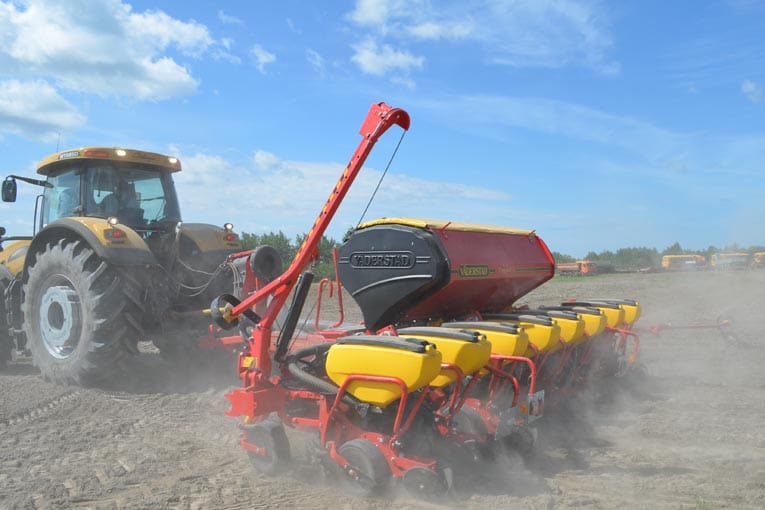Tempo runs at high speeds

The Tempo R12 twelve-row cultivating seeder from the Swedish Vaderstad corporate group set a new record, sowing 306 hectares with sunflower within 24 hours. The sowing proceeded at a breath-taking speed of 19 km/h. The seeding experiment took place in Bulgaria in early April. Tempo has operated on the Russian fields for two years, also setting records both in speed and in seeding precision.
When Tempo first appeared on the Russian market, many could not believe it was possible to seed so easily, to say nothing of doing it with a cultivating seeder. The highest speed attained by conventional precision seeding machines is 8 to 9 km/h.
However, Vaderstad’s 15 years of development effort bore the desired fruit. This became possible thanks to an essentially new seeding device. In the Tempo, the seed movement is monitored the whole way from the bin to the seed bed. The seed does not fall “freely” as it does in the mechanical or pneumatic batching system of other seeders. The Tempo seeding device moves the seeds using high pressure. Passing through a narrow pipe, the seed does not fall but shoots into the ground without bouncing from the bed as so often happens on other seeders working at high speed and intense vibration.
The seeding precision is monitored by seed sensors delivering info to the dashboard/control panel in the tractor cabin about omissions, doublets, planting precision, number of seeds per hectare and distance between seeds. The seeding rate is also set using the dashboard.
Says Sergey Korostelyov, deputy director-general for production, Muchkap-Niva LLC, Tambov oblast:
“Last year we purchased two Tempo 8-row machines, plus one more this year. We believe that our purchase is the best recommendation. In a single season, Tempo convinced us that it is second to none in terms of seeding precision and productivity. Last season two seeders operated sowing maize and sunflowers. The machines maintain the embedding depth and seeding rate with the accuracy of a clock. The sprouting was even and regular. I have never seen such a result on other seeders. The field came up with sprouts as if at a command! Each machine has done a job on 2,000 hectares. We sowed 80 to 100 hectares in a day. We could do more, but the low tractor power (155 hp) restricted our speed to 13-15 km/h, which is also quite good compared to the normal 8 km/h. We also tried using a 200 hp tractor, which in no way affected the seeding precision in spite of the high speed of 19-20 km/h. So this season we shall hitch all of the Tempo machines to the more powerful tractors. We liked Tempo’s large fertiliser bin (1,700 l). This minimises operational downtime, thus increasing the productivity. The bins on other seeders are small and often needed fertiliser replenishment. This takes up time, which, as the saying goes, is money.”
Vaderstad has always heeded the opinion of farmers from all over the world, and this has helped to make more advanced equipment. In 2013, following the 8-row Tempo model, the company turned out a 12-row counterpart expressly for Russian fields. In 2014, the air intake on the seeders was raised from the middle part to the upper in order to reduce dust penetration. In addition to Tempo fitted with a standard drive gear, Vaderstad also turned out a model driven by the tractor hydraulics.
The seeder’s smart capabilities have grown, too. Now all such parameters are supervised by new software known as E-services, whereby the normal monitor is replaced by an iPad. This is much more convenient due to the larger display, higher image resolution and “unattachment” to the tractor cabin. The tablet computer is already loaded with the 3D catalogue of Vaderstad spare parts, making it possible to choose and order spares right on the field.